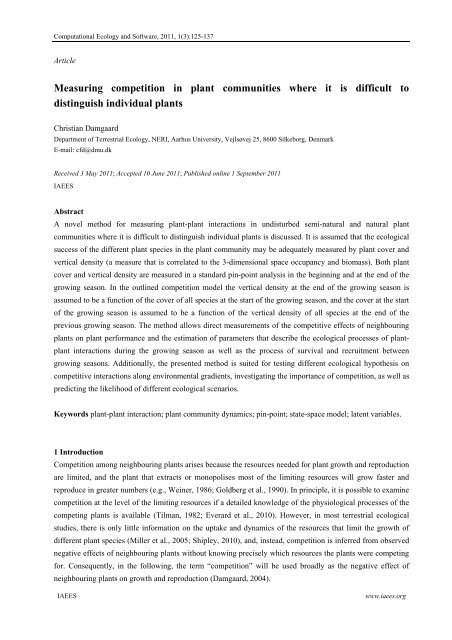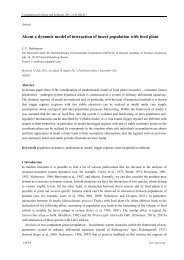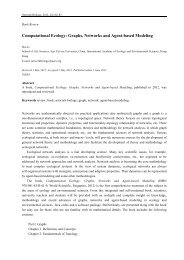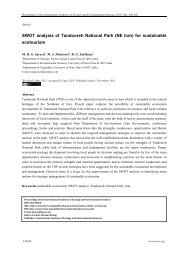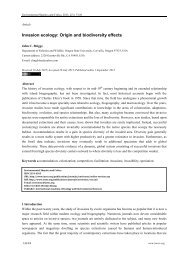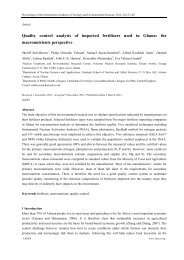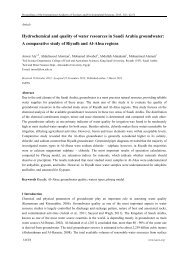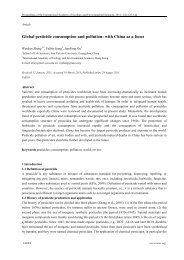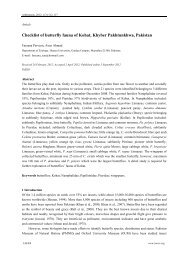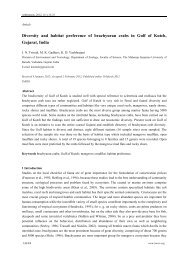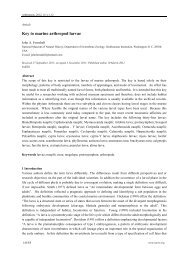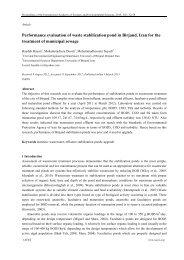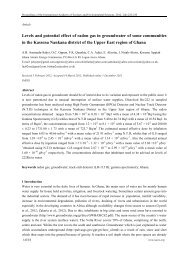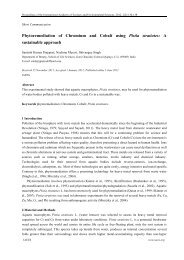Measuring competition in plant communities where it is difficult to ...
Measuring competition in plant communities where it is difficult to ...
Measuring competition in plant communities where it is difficult to ...
Create successful ePaper yourself
Turn your PDF publications into a flip-book with our unique Google optimized e-Paper software.
Computational Ecology and Software, 2011, 1(3):125-137<br />
Article<br />
<strong>Measur<strong>in</strong>g</strong> <strong>compet<strong>it</strong>ion</strong> <strong>in</strong> <strong>plant</strong> <strong>commun<strong>it</strong>ies</strong> <strong>where</strong> <strong>it</strong> <strong>is</strong> <strong>difficult</strong> <strong>to</strong><br />
d<strong>is</strong>t<strong>in</strong>gu<strong>is</strong>h <strong>in</strong>dividual <strong>plant</strong>s<br />
Chr<strong>is</strong>tian Damgaard<br />
Department of Terrestrial Ecology, NERI, Aarhus Univers<strong>it</strong>y, Vejlsøvej 25, 8600 Silkeborg, Denmark<br />
E-mail: cfd@dmu.dk<br />
Received 3 May 2011; Accepted 10 June 2011; Publ<strong>is</strong>hed onl<strong>in</strong>e 1 September 2011<br />
IAEES<br />
Abstract<br />
A novel method for measur<strong>in</strong>g <strong>plant</strong>-<strong>plant</strong> <strong>in</strong>teractions <strong>in</strong> und<strong>is</strong>turbed semi-natural and natural <strong>plant</strong><br />
<strong>commun<strong>it</strong>ies</strong> <strong>where</strong> <strong>it</strong> <strong>is</strong> <strong>difficult</strong> <strong>to</strong> d<strong>is</strong>t<strong>in</strong>gu<strong>is</strong>h <strong>in</strong>dividual <strong>plant</strong>s <strong>is</strong> d<strong>is</strong>cussed. It <strong>is</strong> assumed that the ecological<br />
success of the different <strong>plant</strong> species <strong>in</strong> the <strong>plant</strong> commun<strong>it</strong>y may be adequately measured by <strong>plant</strong> cover and<br />
vertical dens<strong>it</strong>y (a measure that <strong>is</strong> correlated <strong>to</strong> the 3-dimensional space occupancy and biomass). Both <strong>plant</strong><br />
cover and vertical dens<strong>it</strong>y are measured <strong>in</strong> a standard p<strong>in</strong>-po<strong>in</strong>t analys<strong>is</strong> <strong>in</strong> the beg<strong>in</strong>n<strong>in</strong>g and at the end of the<br />
grow<strong>in</strong>g season. In the outl<strong>in</strong>ed <strong>compet<strong>it</strong>ion</strong> model the vertical dens<strong>it</strong>y at the end of the grow<strong>in</strong>g season <strong>is</strong><br />
assumed <strong>to</strong> be a function of the cover of all species at the start of the grow<strong>in</strong>g season, and the cover at the start<br />
of the grow<strong>in</strong>g season <strong>is</strong> assumed <strong>to</strong> be a function of the vertical dens<strong>it</strong>y of all species at the end of the<br />
previous grow<strong>in</strong>g season. The method allows direct measurements of the compet<strong>it</strong>ive effects of neighbour<strong>in</strong>g<br />
<strong>plant</strong>s on <strong>plant</strong> performance and the estimation of parameters that describe the ecological processes of <strong>plant</strong><strong>plant</strong><br />
<strong>in</strong>teractions dur<strong>in</strong>g the grow<strong>in</strong>g season as well as the process of survival and recru<strong>it</strong>ment between<br />
grow<strong>in</strong>g seasons. Add<strong>it</strong>ionally, the presented method <strong>is</strong> su<strong>it</strong>ed for test<strong>in</strong>g different ecological hypothes<strong>is</strong> on<br />
compet<strong>it</strong>ive <strong>in</strong>teractions along environmental gradients, <strong>in</strong>vestigat<strong>in</strong>g the importance of <strong>compet<strong>it</strong>ion</strong>, as well as<br />
predict<strong>in</strong>g the likelihood of different ecological scenarios.<br />
Keywords <strong>plant</strong>-<strong>plant</strong> <strong>in</strong>teraction; <strong>plant</strong> commun<strong>it</strong>y dynamics; p<strong>in</strong>-po<strong>in</strong>t; state-space model; latent variables.<br />
1 Introduction<br />
Compet<strong>it</strong>ion among neighbour<strong>in</strong>g <strong>plant</strong>s ar<strong>is</strong>es because the resources needed for <strong>plant</strong> growth and reproduction<br />
are lim<strong>it</strong>ed, and the <strong>plant</strong> that extracts or monopol<strong>is</strong>es most of the lim<strong>it</strong><strong>in</strong>g resources will grow faster and<br />
reproduce <strong>in</strong> greater numbers (e.g., We<strong>in</strong>er, 1986; Goldberg et al., 1990). In pr<strong>in</strong>ciple, <strong>it</strong> <strong>is</strong> possible <strong>to</strong> exam<strong>in</strong>e<br />
<strong>compet<strong>it</strong>ion</strong> at the level of the lim<strong>it</strong><strong>in</strong>g resources if a detailed knowledge of the physiological processes of the<br />
compet<strong>in</strong>g <strong>plant</strong>s <strong>is</strong> available (Tilman, 1982; Everard et al., 2010). However, <strong>in</strong> most terrestrial ecological<br />
studies, there <strong>is</strong> only l<strong>it</strong>tle <strong>in</strong>formation on the uptake and dynamics of the resources that lim<strong>it</strong> the growth of<br />
different <strong>plant</strong> species (Miller et al., 2005; Shipley, 2010), and, <strong>in</strong>stead, <strong>compet<strong>it</strong>ion</strong> <strong>is</strong> <strong>in</strong>ferred from observed<br />
negative effects of neighbour<strong>in</strong>g <strong>plant</strong>s w<strong>it</strong>hout know<strong>in</strong>g prec<strong>is</strong>ely which resources the <strong>plant</strong>s were compet<strong>in</strong>g<br />
for. Consequently, <strong>in</strong> the follow<strong>in</strong>g, the term “<strong>compet<strong>it</strong>ion</strong>” will be used broadly as the negative effect of<br />
neighbour<strong>in</strong>g <strong>plant</strong>s on growth and reproduction (Damgaard, 2004).<br />
IAEES<br />
www.iaees.org
126<br />
Computational Ecology and Software, 2011, 1(3):125-137<br />
The possibly important role of <strong>in</strong>terspecific compet<strong>it</strong>ive <strong>in</strong>teractions <strong>in</strong> regulat<strong>in</strong>g natural <strong>plant</strong> <strong>commun<strong>it</strong>ies</strong><br />
(e.g., Weiher et al., 1998; Silver<strong>to</strong>wn et al., 1999; Gotelli and McCabe, 2002) has been <strong>in</strong>vestigated <strong>in</strong> a<br />
mult<strong>it</strong>ude of studies that have used different methods for attack<strong>in</strong>g the question. The used methods may be<br />
categor<strong>is</strong>ed broadly <strong>in</strong><strong>to</strong> i) whether the study has been made <strong>in</strong> und<strong>is</strong>turbed <strong>plant</strong> <strong>commun<strong>it</strong>ies</strong> or <strong>in</strong>volved<br />
manipulative treatments; and ii) whether the process of <strong>compet<strong>it</strong>ion</strong> was studied directly by measur<strong>in</strong>g the<br />
effect of dens<strong>it</strong>y on the performance of <strong>in</strong>dividual <strong>plant</strong>s or <strong>in</strong>directly by <strong>in</strong>ferr<strong>in</strong>g <strong>in</strong>terspecific compet<strong>it</strong>ive<br />
relationships as the causal mechan<strong>is</strong>ms that underlie observed changes <strong>in</strong> species abundance or specific<br />
patterns <strong>in</strong> the d<strong>is</strong>tribution of species (Table 1).<br />
Direct<br />
Indirect<br />
Table 1 Methods for study<strong>in</strong>g <strong>in</strong>terspecific compet<strong>it</strong>ive <strong>in</strong>teractions <strong>in</strong> natural <strong>plant</strong> <strong>commun<strong>it</strong>ies</strong>.<br />
Und<strong>is</strong>turbed <strong>commun<strong>it</strong>ies</strong><br />
Manipulative experiments<br />
Neighbourhood analys<strong>is</strong><br />
Fixed-pos<strong>it</strong>ioned p<strong>in</strong>-po<strong>in</strong>t frames<br />
Observed changes <strong>in</strong> species compos<strong>it</strong>ion<br />
Non-random spatial d<strong>is</strong>tribution of species<br />
Niche separation<br />
Space for time subst<strong>it</strong>ution<br />
Compet<strong>it</strong>ion experiments<br />
Removal and phy<strong>to</strong>meter experiments<br />
Observed changes <strong>in</strong> synthetic or<br />
experimental <strong>plant</strong> <strong>commun<strong>it</strong>ies</strong><br />
Most studies of <strong>plant</strong> <strong>compet<strong>it</strong>ion</strong> are manipulated experiments <strong>where</strong> dens<strong>it</strong>y and/or the proportion of<br />
different species are varied and the biomass or fecund<strong>it</strong>y of the compet<strong>in</strong>g species are measured. Often, such<br />
<strong>compet<strong>it</strong>ion</strong> experiments are made <strong>in</strong> rather artificial environmental cond<strong>it</strong>ions, e.g. w<strong>it</strong>h a lim<strong>it</strong>ed number of<br />
<strong>in</strong>dividuals <strong>in</strong> small plots (e.g. Firbank and Watk<strong>in</strong>son, 1985; Law and Watk<strong>in</strong>son, 1987; Damgaard, 1998),<br />
but s<strong>in</strong>ce there has been an <strong>in</strong>creas<strong>in</strong>g awareness that the <strong>in</strong>terspecific <strong>in</strong>teractions cr<strong>it</strong>ically depend on the<br />
abiotic and biotic sett<strong>in</strong>g, <strong>it</strong> <strong>is</strong> now more common <strong>to</strong> conduct ecological manipulation experiments <strong>in</strong> natural<br />
<strong>plant</strong> <strong>commun<strong>it</strong>ies</strong>, <strong>where</strong> the dens<strong>it</strong>y of e<strong>it</strong>her the neighbours (removal experiments) or the target species<br />
(phy<strong>to</strong>meter experiments) has been manipulated (Goldberg and Bar<strong>to</strong>n, 1992). Unfortunately, removal and<br />
phy<strong>to</strong>meter experiments are mostly su<strong>it</strong>ed for qual<strong>it</strong>ative demonstrations of possible compet<strong>it</strong>ive <strong>in</strong>teractions,<br />
and the experiments do not enable the formulation of quant<strong>it</strong>ative descriptions of the <strong>in</strong>terspecific compet<strong>it</strong>ive<br />
<strong>in</strong>teractions at variable local dens<strong>it</strong>ies. Furthermore, there has been a r<strong>is</strong><strong>in</strong>g awareness that the manipulations<br />
may have important local ecosystem effects, e.g. <strong>in</strong> the soil and on the behaviour of herbivores (Corcket et al.,<br />
2003), and other methods for measur<strong>in</strong>g <strong>compet<strong>it</strong>ion</strong> <strong>in</strong> und<strong>is</strong>turbed natural <strong>plant</strong> <strong>commun<strong>it</strong>ies</strong> have been a<br />
<strong>to</strong>pic of r<strong>is</strong><strong>in</strong>g <strong>in</strong>terest (Freckle<strong>to</strong>n and Watk<strong>in</strong>son, 2001).<br />
An <strong>in</strong>creas<strong>in</strong>gly popular method has been <strong>to</strong> <strong>in</strong>fer <strong>in</strong>terspecific compet<strong>it</strong>ive relationships <strong>in</strong>directly as the<br />
causal mechan<strong>is</strong>ms underly<strong>in</strong>g observed changes <strong>in</strong> species abundance or specific patterns <strong>in</strong> the d<strong>is</strong>tribution<br />
of <strong>plant</strong> species <strong>in</strong> natural <strong>commun<strong>it</strong>ies</strong> (Zhang, 2011). For example, Rees et al. (1996) analysed observed<br />
changes <strong>in</strong> the d<strong>is</strong>tribution of annual <strong>plant</strong>s <strong>in</strong> thousands of small quadrates <strong>in</strong> a fixed dune <strong>plant</strong> commun<strong>it</strong>y,<br />
and Law et al. (1997) estimated <strong>compet<strong>it</strong>ion</strong> coefficients from spatial turnover data of four perennial grass<br />
species (see also Freckle<strong>to</strong>n et al., 2000; Adler et al., 2006; Farrer et al., 2010). Other researchers have<br />
suggested that non-random spatial d<strong>is</strong>tribution of species <strong>is</strong> the f<strong>in</strong>gerpr<strong>in</strong>t of <strong>compet<strong>it</strong>ion</strong> that has taken place<br />
<strong>in</strong> the past (Conner and Simberloff, 1979; Wilson et al., 1996; Law et al., 1997; Gotelli and McCabe, 2002),<br />
and Silver<strong>to</strong>wn et al. (1999) demonstrated niche separation along a hydrological gradient. Add<strong>it</strong>ionally,<br />
IAEES<br />
www.iaees.org
Computational Ecology and Software, 2011, 1(3):125-137<br />
127<br />
compet<strong>it</strong>ive mechan<strong>is</strong>ms <strong>in</strong> natural <strong>plant</strong> <strong>commun<strong>it</strong>ies</strong> have been <strong>in</strong>ferred from compar<strong>in</strong>g <strong>plant</strong> <strong>commun<strong>it</strong>ies</strong><br />
at different successional stages, the so-called “space for time subst<strong>it</strong>ution” (Barclay-Estrup and Gim<strong>in</strong>gham,<br />
1969; Bakker et al., 1996). F<strong>in</strong>ally, for test<strong>in</strong>g specific ecological hypotheses, <strong>it</strong> may be <strong>difficult</strong> <strong>to</strong> f<strong>in</strong>d natural<br />
<strong>plant</strong> <strong>commun<strong>it</strong>ies</strong> w<strong>it</strong>h the required variation <strong>in</strong> the <strong>in</strong><strong>it</strong>ial cond<strong>it</strong>ions and <strong>it</strong> has, therefore, become<br />
<strong>in</strong>creas<strong>in</strong>gly popular <strong>to</strong> study the mechan<strong>is</strong>m of <strong>compet<strong>it</strong>ion</strong> <strong>in</strong>directly by observ<strong>in</strong>g changes <strong>in</strong> synthetic or<br />
experimental <strong>plant</strong> <strong>commun<strong>it</strong>ies</strong> (Fukami et al., 2005; Ejrnæs et al., 2006; Fridley et al., 2007).<br />
The development of <strong>in</strong>direct methods for <strong>in</strong>ferr<strong>in</strong>g <strong>in</strong>terspecific compet<strong>it</strong>ive relationships has had a central<br />
role <strong>in</strong> the <strong>in</strong>creas<strong>in</strong>g awareness of the importance of l<strong>in</strong>k<strong>in</strong>g ecological data w<strong>it</strong>h quant<strong>it</strong>ative population<br />
models by means of advanced stat<strong>is</strong>tical approaches (Rees et al., 1996; Clark, 2007). However, <strong>in</strong> order <strong>to</strong> test<br />
specific hypotheses on the role of <strong>plant</strong> <strong>compet<strong>it</strong>ion</strong> <strong>in</strong> determ<strong>in</strong><strong>in</strong>g <strong>plant</strong> commun<strong>it</strong>y structures, <strong>it</strong> <strong>is</strong> necessary<br />
<strong>to</strong> make a direct l<strong>in</strong>k between the spatial arrangement of neighbour<strong>in</strong>g <strong>plant</strong>s and <strong>plant</strong> performance. Such<br />
direct studies of the importance of <strong>compet<strong>it</strong>ion</strong> have been performed under the head<strong>in</strong>g of neighbourhood<br />
analyses, <strong>where</strong> the effect of the d<strong>is</strong>tance between neighbour<strong>in</strong>g <strong>plant</strong>s on <strong>plant</strong> performance <strong>is</strong> quantified.<br />
Pacala and Silander (1990) described the commun<strong>it</strong>y dynamics between two annual <strong>plant</strong> species <strong>in</strong> a<br />
neighbourhood analys<strong>is</strong>, and Turnbull et al. (2004) estimated the <strong>in</strong>dividual-level <strong>compet<strong>it</strong>ion</strong> coefficients for<br />
seven annuals grow<strong>in</strong>g <strong>in</strong> limes<strong>to</strong>ne grassland over 2 years. However, the method of neighbourhood analys<strong>is</strong> <strong>is</strong><br />
only feasible <strong>in</strong> <strong>plant</strong> <strong>commun<strong>it</strong>ies</strong> that are dom<strong>in</strong>ated by <strong>plant</strong> species <strong>where</strong> <strong>it</strong> <strong>is</strong> easy <strong>to</strong> d<strong>is</strong>t<strong>in</strong>gu<strong>is</strong>h<br />
<strong>in</strong>dividual <strong>plant</strong>s, and many open natural herbal and grassland <strong>commun<strong>it</strong>ies</strong> are dom<strong>in</strong>ated by perennial species<br />
that form dense vegetation <strong>where</strong> <strong>it</strong> <strong>is</strong> <strong>difficult</strong> <strong>to</strong> d<strong>is</strong>t<strong>in</strong>gu<strong>is</strong>h <strong>in</strong>dividual <strong>plant</strong>s and, consequently, <strong>to</strong> determ<strong>in</strong>e<br />
dens<strong>it</strong>y. Furthermore, if <strong>in</strong>dividual <strong>plant</strong>s may be d<strong>is</strong>t<strong>in</strong>gu<strong>is</strong>hed, they almost always vary markedly <strong>in</strong> size, so<br />
that the number of neighbour<strong>in</strong>g <strong>in</strong>dividuals w<strong>it</strong>h<strong>in</strong> a certa<strong>in</strong> d<strong>is</strong>tance <strong>is</strong> of lim<strong>it</strong>ed value for describ<strong>in</strong>g the<br />
amount of <strong>compet<strong>it</strong>ion</strong> experienced by the target <strong>plant</strong>. More generally, the degree of <strong>compet<strong>it</strong>ion</strong> experienced<br />
by the target <strong>plant</strong> <strong>is</strong> expected <strong>to</strong> be species-specific spatial functions (<strong>compet<strong>it</strong>ion</strong> kernels or field-ofneighbourhoods)<br />
that depend cr<strong>it</strong>ically on the size and d<strong>is</strong>tances of the neighbour<strong>in</strong>g <strong>plant</strong>s (Berger and<br />
Hildenbrandt, 2000), and such field-of-neighbourhoods are not easily estimated <strong>in</strong> <strong>plant</strong> <strong>commun<strong>it</strong>ies</strong> w<strong>it</strong>h<br />
several species.<br />
In th<strong>is</strong> paper a novel method for measur<strong>in</strong>g <strong>compet<strong>it</strong>ion</strong> <strong>in</strong> und<strong>is</strong>turbed natural <strong>plant</strong> <strong>commun<strong>it</strong>ies</strong> <strong>is</strong><br />
d<strong>is</strong>cussed. The method allows direct measurements of the compet<strong>it</strong>ive effects of neighbour<strong>in</strong>g <strong>plant</strong>s on <strong>plant</strong><br />
performance and the estimation of parameters that describe the ecological processes of <strong>plant</strong>-<strong>plant</strong> <strong>in</strong>teractions<br />
dur<strong>in</strong>g the grow<strong>in</strong>g season as well as the process of survival and recru<strong>it</strong>ment between grow<strong>in</strong>g seasons us<strong>in</strong>g<br />
data from a standard p<strong>in</strong>-po<strong>in</strong>t analys<strong>is</strong> (Damgaard et al., 2009). In a p<strong>in</strong>-po<strong>in</strong>t analys<strong>is</strong>, a frame w<strong>it</strong>h a fixed<br />
grid pattern <strong>is</strong> placed above the vegetation. At each grid po<strong>in</strong>t, a p<strong>in</strong> <strong>is</strong> <strong>in</strong>serted vertically <strong>in</strong><strong>to</strong> the vegetation<br />
and the number of times the p<strong>in</strong> <strong>to</strong>uches different <strong>plant</strong> species <strong>is</strong> recorded (Levy and Madden, 1933; Kent and<br />
Coker, 1992). A p<strong>in</strong>-po<strong>in</strong>t measurement provides estimates of two important <strong>plant</strong> ecological variables: cover<br />
and vertical dens<strong>it</strong>y. The species cover <strong>is</strong> the relative area that a species “covers” when projected on<strong>to</strong> the twodimensional<br />
ground surface and, <strong>in</strong> a p<strong>in</strong>-po<strong>in</strong>t analys<strong>is</strong>, cover <strong>is</strong> estimated by the relative number of p<strong>in</strong>s that<br />
<strong>to</strong>uch the species. It <strong>is</strong> argued that cover <strong>in</strong> many open perennial <strong>plant</strong> <strong>commun<strong>it</strong>ies</strong> will be a more su<strong>it</strong>able<br />
predic<strong>to</strong>r of the compet<strong>it</strong>ive <strong>in</strong>teractions than local <strong>plant</strong> dens<strong>it</strong>y. The vertical dens<strong>it</strong>y <strong>is</strong> def<strong>in</strong>ed as the number<br />
of times a s<strong>in</strong>gle p<strong>in</strong> h<strong>it</strong>s a specific species (for a d<strong>is</strong>cussion on term<strong>in</strong>ology see Wilson, 2011), th<strong>is</strong> measure <strong>is</strong><br />
pos<strong>it</strong>ively related <strong>to</strong> the 3-dimensional space occupancy (or volume) of the species and has been shown <strong>to</strong> be a<br />
non-l<strong>in</strong>ear function of <strong>plant</strong> biomass (Jonasson, 1983, 1988). For most <strong>plant</strong> species, both the cover and the<br />
vertical dens<strong>it</strong>y will be relevant measures of the ecological success of the species (Damgaard et al., 2009).<br />
IAEES<br />
www.iaees.org
128<br />
Computational Ecology and Software, 2011, 1(3):125-137<br />
The difference between a neighbourhood analys<strong>is</strong> and the presented p<strong>in</strong>-po<strong>in</strong>t method <strong>is</strong> that <strong>in</strong> a<br />
neighbourhood analys<strong>is</strong>, the performance of <strong>in</strong>dividual target <strong>plant</strong>s <strong>is</strong> measured, <strong>where</strong>as <strong>in</strong> the p<strong>in</strong>-po<strong>in</strong>t<br />
method, the performance of different spatial ent<strong>it</strong>ies of a species <strong>is</strong> measured by a spatial sampl<strong>in</strong>g approach,<br />
w<strong>it</strong>hout d<strong>is</strong>t<strong>in</strong>gu<strong>is</strong>h<strong>in</strong>g <strong>in</strong>dividual <strong>plant</strong>s. The p<strong>in</strong>-po<strong>in</strong>t method of measur<strong>in</strong>g <strong>compet<strong>it</strong>ion</strong> <strong>is</strong>, therefore,<br />
especially su<strong>it</strong>ed <strong>in</strong> <strong>plant</strong> <strong>commun<strong>it</strong>ies</strong> that are dom<strong>in</strong>ated by perennial herbal and grass species, <strong>where</strong> <strong>it</strong> <strong>is</strong><br />
<strong>difficult</strong> <strong>to</strong> d<strong>is</strong>t<strong>in</strong>gu<strong>is</strong>h <strong>in</strong>dividual <strong>plant</strong>s.<br />
The idea underly<strong>in</strong>g the method of measur<strong>in</strong>g <strong>compet<strong>it</strong>ion</strong> <strong>is</strong>:<br />
i) To express the vertical dens<strong>it</strong>y at the end of the grow<strong>in</strong>g season as a function of the cover of all species at<br />
the start of the grow<strong>in</strong>g season, i.e. the vertical dens<strong>it</strong>y of a species at the end of the grow<strong>in</strong>g season will<br />
reflect the growth of the species w<strong>it</strong>h<strong>in</strong> the p<strong>in</strong>-po<strong>in</strong>t frame, which will depend on the cover of the species <strong>in</strong><br />
the beg<strong>in</strong>n<strong>in</strong>g of the season, availabil<strong>it</strong>y of resources, and the cover of the other compet<strong>in</strong>g species <strong>in</strong> the<br />
beg<strong>in</strong>n<strong>in</strong>g of the season.<br />
ii) To express the cover at the start of the grow<strong>in</strong>g season as a function of the vertical dens<strong>it</strong>y at the end of<br />
the previous grow<strong>in</strong>g season, i.e. <strong>plant</strong>s are expected <strong>to</strong> allocate resources <strong>in</strong><strong>to</strong> occupy<strong>in</strong>g space the follow<strong>in</strong>g<br />
year (on the Northern hem<strong>is</strong>phere), and a <strong>plant</strong> species that grows <strong>to</strong> a relatively high vertical dens<strong>it</strong>y at the<br />
end of the grow<strong>in</strong>g season <strong>is</strong> expected <strong>to</strong> have a relatively high <strong>plant</strong> cover the follow<strong>in</strong>g year.<br />
In the follow<strong>in</strong>g outl<strong>in</strong>e of the method <strong>it</strong> will be d<strong>is</strong>cussed how <strong>to</strong> i) sample cover and vertical dens<strong>it</strong>y data<br />
<strong>in</strong> fixed-pos<strong>it</strong>ioned p<strong>in</strong>-po<strong>in</strong>t frames; ii) model the observed compet<strong>it</strong>ive <strong>in</strong>teractions; and iii) make predictions<br />
on the future states of the <strong>plant</strong> commun<strong>it</strong>y.<br />
For reasons of simplic<strong>it</strong>y the effects of one or more abiotic environmental gradients on the <strong>plant</strong>-<strong>plant</strong><br />
<strong>in</strong>teractions have been ignored <strong>in</strong> the above <strong>in</strong>troduction. However, <strong>in</strong> most current fundamental and applied<br />
<strong>plant</strong> ecological questions, e.g. the importance of <strong>compet<strong>it</strong>ion</strong> <strong>in</strong> structur<strong>in</strong>g <strong>plant</strong> <strong>commun<strong>it</strong>ies</strong>, the possible<br />
evidence of niche separation, and prediction of the consequences of environmental changes on ecosystems, the<br />
preferred method of research <strong>is</strong> <strong>to</strong> study <strong>plant</strong>-<strong>plant</strong> <strong>in</strong>teractions along one or more environmental gradients<br />
(e.g. Silver<strong>to</strong>wn et al., 1999; Damgaard, 2003). Consequently, <strong>it</strong> will be assumed that the <strong>compet<strong>it</strong>ion</strong> study<br />
will be performed along a s<strong>in</strong>gle environmental gradient and that the research question will <strong>in</strong>volve the<br />
possible effects of the environmental gradient on the <strong>plant</strong> commun<strong>it</strong>y dynamics.<br />
2 Data Collection<br />
Depend<strong>in</strong>g on the number, size d<strong>is</strong>tribution and spatial arrangement of the <strong>plant</strong> species <strong>in</strong> the studied <strong>plant</strong><br />
commun<strong>it</strong>y a p<strong>in</strong>-po<strong>in</strong>t frame of a fixed size and a specific number of equid<strong>is</strong>tant grid-po<strong>in</strong>ts <strong>is</strong> chosen.<br />
Generally, the d<strong>is</strong>tance between the grid-po<strong>in</strong>ts should <strong>in</strong>crease w<strong>it</strong>h size and <strong>in</strong>traspecific aggregation of the<br />
<strong>plant</strong> species, but there are no fixed recommendations <strong>to</strong> the design of the p<strong>in</strong>-po<strong>in</strong>t frame, except that <strong>it</strong> <strong>is</strong><br />
hard on the back if the size of the p<strong>in</strong>-po<strong>in</strong>t frame <strong>is</strong> <strong>to</strong>o large. If the <strong>plant</strong> commun<strong>it</strong>y has been dig<strong>it</strong>ized or the<br />
size d<strong>is</strong>tribution and <strong>in</strong>traspecific aggregation <strong>is</strong> known, then <strong>it</strong> <strong>is</strong> possible <strong>to</strong> simulate the stat<strong>is</strong>tical power of<br />
different designs of the p<strong>in</strong>-po<strong>in</strong>t frame.<br />
In the field, a number of fixed mark<strong>in</strong>gs are placed along the environmental gradient <strong>in</strong> such a way that the<br />
pos<strong>it</strong>ion of the frame and the p<strong>in</strong>s are uniquely determ<strong>in</strong>ed (the <strong>in</strong>formation on the p<strong>in</strong>-pos<strong>it</strong>ion w<strong>it</strong>h<strong>in</strong> the<br />
frames <strong>is</strong> not used <strong>in</strong> the outl<strong>in</strong>ed model below, but th<strong>is</strong> <strong>in</strong>formation may be used for other purposes as<br />
expla<strong>in</strong>ed <strong>in</strong> the d<strong>is</strong>cussion). The fixed-pos<strong>it</strong>ioned p<strong>in</strong>-po<strong>in</strong>t frames do not have <strong>to</strong> be randomly placed; if the<br />
research question <strong>is</strong> centred on a couple of key-ecological species then the stat<strong>is</strong>tical power of the <strong>compet<strong>it</strong>ion</strong><br />
IAEES<br />
www.iaees.org
Computational Ecology and Software, 2011, 1(3):125-137<br />
129<br />
experiment <strong>is</strong> <strong>in</strong>creased if the p<strong>in</strong>-po<strong>in</strong>t frames are placed <strong>in</strong> such a way that the species co-occur <strong>in</strong> variable<br />
abundances and proportion.<br />
The cover of the different species <strong>is</strong> determ<strong>in</strong>ed at the beg<strong>in</strong>n<strong>in</strong>g of the grow<strong>in</strong>g season. The vertical dens<strong>it</strong>y<br />
of the different species <strong>is</strong> determ<strong>in</strong>ed and at the end of the grow<strong>in</strong>g season. When the data <strong>is</strong> collected, all<br />
species are recorded, but when the data are modelled, <strong>it</strong> will most likely be necessary <strong>to</strong> aggregate the species<br />
<strong>in</strong><strong>to</strong> different classes (Damgaard et al., 2009), or model the parameters as functions of species tra<strong>it</strong>s (Com<strong>it</strong>a et<br />
al., 2010), e.g. by modell<strong>in</strong>g the <strong>compet<strong>it</strong>ion</strong> coefficients by the height and specific leaf area of the species.<br />
The first data collection may be performed e<strong>it</strong>her at the beg<strong>in</strong>n<strong>in</strong>g or at the end of the grow<strong>in</strong>g season, and<br />
the experiment may cont<strong>in</strong>ue for as long as possible. If data are collected <strong>in</strong> atypical years, e.g. very wet years<br />
or very dry years, such data may be analysed separately and provide a unique opportun<strong>it</strong>y for exam<strong>in</strong><strong>in</strong>g the<br />
effect of extreme climatic cond<strong>it</strong>ions on <strong>plant</strong> commun<strong>it</strong>y dynamics.<br />
t 1<br />
Year 1<br />
t 2<br />
X i , t 1<br />
t 1 t<br />
2<br />
x i , t 1 y i , t 2<br />
x i , t 1<br />
x i , t<br />
2<br />
M1<br />
M2<br />
M1<br />
X i , t 1 Y i , t 2<br />
X i<br />
, t<br />
2<br />
P1:<br />
Compet<strong>it</strong>ive<br />
growth<br />
P2:<br />
Survival and<br />
establ<strong>is</strong>hment<br />
P1:<br />
Compet<strong>it</strong>ive<br />
growth<br />
Year 2<br />
Fig. 1 Graphical model of the state-space model, the observations, and the studied compet<strong>it</strong>ive processes; the compet<strong>it</strong>ive growth<br />
dur<strong>in</strong>g the grow<strong>in</strong>g season (from t 1 <strong>to</strong> t 2 ) <strong>is</strong> modelled by the process equation P1 which expresses the vertical dens<strong>it</strong>y of the<br />
different species at t 2 as a function of the cover of all species at t 1 , and survival and establ<strong>is</strong>hment between grow<strong>in</strong>g season (from<br />
t 2 <strong>to</strong> t 1 the follow<strong>in</strong>g year) <strong>is</strong> modelled by the process equation P2 which expresses the cover at t 1 the follow<strong>in</strong>g year as a function<br />
of the vertical dens<strong>it</strong>y at t 2 the previous year. The unknown states of cover and vertical dens<strong>it</strong>y of the different species are<br />
modelled by latent variables (square boxes), and the latent variables are connected <strong>to</strong> measurements of the cover at t 1 and the<br />
vertical dens<strong>it</strong>y at t 2 of the different species (rounded boxes) by the measurement equations M1 and M2.<br />
3 Compet<strong>it</strong>ion Model<br />
The compet<strong>it</strong>ive <strong>in</strong>teractions along the environmental gradient are modelled by describ<strong>in</strong>g how cover and<br />
vertical dens<strong>it</strong>y of the different species co-vary along the environmental gradient. The changes <strong>in</strong> the cover and<br />
vertical dens<strong>it</strong>y of each species as affected by the compet<strong>it</strong>ive <strong>in</strong>teraction and the environmental gradient <strong>is</strong><br />
modelled <strong>in</strong> a state-space model (the model may also be called a structural equation model or a Bayesian<br />
network), which <strong>is</strong> a general <strong>to</strong>ol for modell<strong>in</strong>g repeated measurements <strong>where</strong> the variables may change<br />
dynamically. The advantage of us<strong>in</strong>g a state-space model for modell<strong>in</strong>g long<strong>it</strong>ud<strong>in</strong>al processes <strong>is</strong> that that the<br />
modelled processes are assumed <strong>to</strong> operate on the state of unbiased latent variables rather than observed values<br />
that may be biased, and that the observed variation <strong>is</strong> separated <strong>in</strong><strong>to</strong> measurement variation and process<br />
IAEES<br />
www.iaees.org
130<br />
Computational Ecology and Software, 2011, 1(3):125-137<br />
variation (Clark, 2007). In the present state-space model (Fig. 1), the studied compet<strong>it</strong>ive processes are<br />
assumed <strong>to</strong> act on latent variables that model <strong>plant</strong> cover and vertical dens<strong>it</strong>y by two process equations (or<br />
structural equations), and the latent variables are coupled <strong>to</strong> the observed <strong>plant</strong> cover and vertical dens<strong>it</strong>y by<br />
two measur<strong>in</strong>g equations.<br />
3.1 State-space model<br />
In order <strong>to</strong> simplify the description of the state-space model below, I will focus on the compet<strong>it</strong>ive effects<br />
experienced by species i when compet<strong>in</strong>g w<strong>it</strong>h two other species, but <strong>it</strong> <strong>is</strong> important <strong>to</strong> keep <strong>in</strong> m<strong>in</strong>d that<br />
similar process and measurement equations may be f<strong>it</strong>ted for all <strong>in</strong>vestigated <strong>plant</strong> species or aggregated taxa.<br />
It <strong>is</strong> assumed that the vertical dens<strong>it</strong>y of species i at the end of the grow<strong>in</strong>g season (t 2 ) <strong>is</strong> an <strong>in</strong>creas<strong>in</strong>g<br />
function of the <strong>plant</strong> cover of species i at the beg<strong>in</strong>n<strong>in</strong>g of the season (t 1 ), a function of the <strong>plant</strong> cover of the<br />
other species j and k at the beg<strong>in</strong>n<strong>in</strong>g of the season, and a function of environmental gradient and the<br />
compet<strong>it</strong>ive growth of <strong>plant</strong> species i <strong>is</strong> modelled as,<br />
b<br />
i<br />
j<br />
k<br />
P1: Y<br />
i, t 2, y,<br />
r<br />
ai<br />
( zr<br />
) X<br />
i,<br />
t1,<br />
y,<br />
r<br />
exp( c<br />
j<br />
( zr<br />
) X<br />
j,<br />
t1,<br />
y,<br />
r<br />
) exp( ck<br />
( zr<br />
) X<br />
k , t1,<br />
y,<br />
r<br />
) <br />
P1,<br />
i,<br />
y,<br />
r<br />
(1)<br />
d<br />
d<br />
<strong>where</strong> the state of <strong>plant</strong> cover of species i at time t <strong>in</strong> year y and p<strong>in</strong>-po<strong>in</strong>t frame r <strong>is</strong> denoted by X i,t,y,r , the state<br />
of the vertical dens<strong>it</strong>y of species i at time t <strong>in</strong> year y and p<strong>in</strong>-po<strong>in</strong>t frame r <strong>is</strong> denoted by Y i,t,y,r , z r <strong>is</strong> the level of<br />
2<br />
the environmental gradient <strong>in</strong> p<strong>in</strong>-po<strong>in</strong>t frame r, and <br />
P1,<br />
i,<br />
y,<br />
r<br />
~ N(0,<br />
<br />
P1,<br />
i)<br />
<strong>is</strong> the residual process variation<br />
dur<strong>in</strong>g the grow<strong>in</strong>g season of species i across different years and p<strong>in</strong>-po<strong>in</strong>t frames. The environment <strong>is</strong><br />
assumed <strong>to</strong> affect the vertical dens<strong>it</strong>y of species i at the end of the season <strong>in</strong> two different ways: i) e<strong>it</strong>her by<br />
affect<strong>in</strong>g growth directly by alter<strong>in</strong>g the relationship between the cover and vertical dens<strong>it</strong>y of species i, i.e. the<br />
function a z ) ; or ii) by affect<strong>in</strong>g the compet<strong>it</strong>ive effect of species j and k, i.e., c z ) and c z ) . These<br />
i<br />
( r<br />
functions may e<strong>it</strong>her be constant, i.e. the growth or the compet<strong>it</strong>ive effect are <strong>in</strong>dependent of the environmental<br />
gradient, l<strong>in</strong>ear functions, sigmoid functions w<strong>it</strong>h a parameter<strong>is</strong>ed threshold value, or functions w<strong>it</strong>h a maximal<br />
value at an <strong>in</strong>termediary value of the environmental gradient (Damgaard 2006), and depend<strong>in</strong>g on which<br />
functional relationship <strong>is</strong> best supported by the data, different ecological hypotheses concern<strong>in</strong>g the effect of<br />
the environmental gradient on growth and compet<strong>it</strong>ive effects may be <strong>in</strong>vestigated, e.g. do different species<br />
have pos<strong>it</strong>ive <strong>in</strong>teraction effects on each other at stressful levels of the environmental gradient (facil<strong>it</strong>ation<br />
hypothes<strong>is</strong>)? Or, <strong>is</strong> there a threshold level of the environmental gradient <strong>where</strong> the magn<strong>it</strong>ude of the<br />
compet<strong>it</strong>ive effects suddenly shift (eco<strong>to</strong>ne or niche separation hypothes<strong>is</strong>)?<br />
It <strong>is</strong> assumed that perennial species w<strong>it</strong>h a relatively large vertical dens<strong>it</strong>y have a relatively larger <strong>plant</strong><br />
cover the follow<strong>in</strong>g year, and the <strong>plant</strong> cover of species i <strong>in</strong> year y+1 <strong>is</strong>, therefore, an <strong>in</strong>creas<strong>in</strong>g function of the<br />
vertical dens<strong>it</strong>y of species i <strong>in</strong> year t, a function of the vertical dens<strong>it</strong>y of other species j and k <strong>in</strong> year t and a<br />
function of the level of environmental gradient, and the survival and recru<strong>it</strong>ment the follow<strong>in</strong>g year of species i<br />
was modelled as,<br />
j<br />
( r<br />
k<br />
( r<br />
b<br />
i<br />
j<br />
k<br />
P2: log<strong>it</strong>(<br />
X<br />
i, t1,<br />
y 1, r<br />
) log<strong>it</strong>( ai<br />
( zr<br />
) Yi<br />
, t 2, y,<br />
r<br />
exp( c<br />
j<br />
( zr<br />
) Yj,<br />
t 2, y,<br />
r<br />
) exp( ck<br />
( zr<br />
) Yk<br />
, t 2, y,<br />
r<br />
)) <br />
P2,<br />
i,<br />
y,<br />
r<br />
(2)<br />
d<br />
d<br />
IAEES<br />
www.iaees.org
Computational Ecology and Software, 2011, 1(3):125-137<br />
131<br />
2<br />
<strong>where</strong> <br />
P 2,<br />
i,<br />
y , r<br />
~ N (0, <br />
P 2, i<br />
) <strong>is</strong> the residual process variation from one grow<strong>in</strong>g season <strong>to</strong> the next of species<br />
i across different years and p<strong>in</strong>-po<strong>in</strong>t frames. Correspond<strong>in</strong>gly, as for (P1), different hypotheses on the effects<br />
of the environmental gradient on survival and establ<strong>is</strong>hment and the <strong>plant</strong>-<strong>plant</strong> <strong>in</strong>teractions may be tested.<br />
Note that the parameters <strong>in</strong> both process equations, (P1) and (P2), have the same notation; th<strong>is</strong> does not mean<br />
that the parameters of the two processes are identical, but only that the parameters w<strong>it</strong>h the same notation have<br />
an analogous <strong>in</strong>terpretation.<br />
The unknown states of the latent variables are connected <strong>to</strong> the observed cover and vertical dens<strong>it</strong>y by the<br />
measurement equations <strong>in</strong> such a way that the latent cover variables are assumed <strong>to</strong> be the probabil<strong>it</strong>y<br />
parameter <strong>in</strong> a b<strong>in</strong>omial d<strong>is</strong>tribution,<br />
M1: u B<strong>in</strong>( n , X )<br />
(3)<br />
i, t,<br />
y,<br />
r<br />
~<br />
i,<br />
t,<br />
y,<br />
r<br />
<strong>where</strong><br />
X<br />
i t , y,<br />
r<br />
,<br />
<strong>is</strong> the latent variable for cover of species i at time t <strong>in</strong> year y at frame r, and u <strong>is</strong> the observed<br />
number of grid po<strong>in</strong>ts <strong>where</strong> the species <strong>is</strong> h<strong>it</strong> by a p<strong>in</strong> <strong>in</strong> the same p<strong>in</strong>-po<strong>in</strong>t frame w<strong>it</strong>h n grid po<strong>in</strong>ts.<br />
The latent vertical dens<strong>it</strong>y variables are assumed <strong>to</strong> be the mean vertical dens<strong>it</strong>y <strong>in</strong> a general<strong>is</strong>ed Po<strong>is</strong>son<br />
d<strong>is</strong>tribution,<br />
M2: v gP(<br />
Y , )<br />
(4)<br />
i, t,<br />
y,<br />
r<br />
~<br />
i,<br />
t,<br />
y,<br />
r M 2,<br />
i<br />
<strong>where</strong><br />
Y<br />
i t , y , r<br />
,<br />
<strong>is</strong> the latent variable for vertical dens<strong>it</strong>y of species i at time t <strong>in</strong> year y at frame r, v <strong>is</strong> as the<br />
observed number of times the species <strong>is</strong> h<strong>it</strong> <strong>in</strong> the same p<strong>in</strong>-po<strong>in</strong>t frame, and <strong>is</strong> the degree of under<br />
d<strong>is</strong>persion, 1<br />
variance<br />
mean<br />
M 2 , i<br />
, compared <strong>to</strong> the Po<strong>is</strong>son d<strong>is</strong>tribution when measur<strong>in</strong>g the number of times a<br />
p<strong>in</strong> h<strong>it</strong>s a specific species <strong>in</strong> the p<strong>in</strong>-po<strong>in</strong>t frame.<br />
The outl<strong>in</strong>ed state-space model <strong>is</strong> only one of many possible models from a large class of possible <strong>plant</strong><strong>plant</strong><br />
<strong>in</strong>teractions models, and the f<strong>it</strong>t<strong>in</strong>g properties of the model should be <strong>in</strong>vestigated and compared <strong>to</strong> other<br />
models. A simple model compar<strong>is</strong>on approach <strong>is</strong> <strong>to</strong> f<strong>it</strong> each process equation (P1 and P2) <strong>in</strong>dependently us<strong>in</strong>g<br />
the observed values of cover and vertical dens<strong>it</strong>y and check the f<strong>it</strong>t<strong>in</strong>g properties of the models us<strong>in</strong>g residual<br />
plots.<br />
3.2 Estimation and stat<strong>is</strong>tical <strong>in</strong>ferences<br />
The state-space model may be parameterized us<strong>in</strong>g numerical Bayesian methods, <strong>where</strong> the jo<strong>in</strong>t posterior<br />
d<strong>is</strong>tribution of the model parameters and the latent variables are calculated us<strong>in</strong>g MCMC (Metropol<strong>is</strong>-Hast<strong>in</strong>gs)<br />
simulations (Carl<strong>in</strong> and Lou<strong>is</strong>, 1996; Clark, 2007).<br />
When us<strong>in</strong>g Bayesian methods, the prior d<strong>is</strong>tribution of the parameters and latent variables needs <strong>to</strong> be<br />
specified, and a simple but robust approach <strong>is</strong> <strong>to</strong> let all parameters and latent variables, except for the<br />
measurement error, ar<strong>is</strong>e from a uniform prior d<strong>is</strong>tribution w<strong>it</strong>h<strong>in</strong> the doma<strong>in</strong> of the parameter. For example,<br />
the latent cover variables, X, are assumed <strong>to</strong> ar<strong>is</strong>e from a uniform prior d<strong>is</strong>tribution between specified<br />
IAEES<br />
www.iaees.org
132<br />
Computational Ecology and Software, 2011, 1(3):125-137<br />
m<strong>in</strong>imum and maximum values of cover. The normal measurement error may be assumed <strong>to</strong> ar<strong>is</strong>e from an<br />
<strong>in</strong>verse gamma d<strong>is</strong>tribution (Carl<strong>in</strong> and Lou<strong>is</strong>, 1996).<br />
Us<strong>in</strong>g a first order Markov assumption, the likelihood function p X<br />
i, t1,<br />
y1, Yi<br />
, t2,<br />
y1,<br />
X<br />
i,<br />
t1,<br />
y2...<br />
Yi<br />
, t2,<br />
yn<br />
may be<br />
described by pY<br />
X pX<br />
| Y<br />
<br />
pX<br />
, <strong>where</strong> <br />
i, t 2, yn<br />
|<br />
i,<br />
t1,<br />
yn i,<br />
t1,<br />
yn i,<br />
t 2, yn 1<br />
...<br />
i,<br />
t1,<br />
y1<br />
p <strong>is</strong> a prior<br />
X i , t1,<br />
y1<br />
d<strong>is</strong>tribution of the latent variable, and s<strong>in</strong>ce the likelihood function of the measurement equations may be<br />
formulated as p u i<br />
| X ) and p v i<br />
| Y ) and the likelihood function of the parameters and the<br />
(<br />
, t,<br />
y,<br />
r i,<br />
t,<br />
y,<br />
r<br />
(<br />
, t,<br />
y,<br />
r i,<br />
t,<br />
y,<br />
r<br />
latent variables as p ( | prior(<br />
)) , then the complete likelihood function of the full state-space model may<br />
be specified by multiply<strong>in</strong>g a number of relatively simple cond<strong>it</strong>ional likelihood expressions (Clark, 2007).<br />
Stat<strong>is</strong>tical <strong>in</strong>ference may be based on the marg<strong>in</strong>al posterior d<strong>is</strong>tribution of the parameters and different<br />
models may be compared us<strong>in</strong>g the deviance <strong>in</strong>formation cr<strong>it</strong>erion (Spiegelhalter et al., 2002).<br />
4 Intens<strong>it</strong>y and Importance of Compet<strong>it</strong>ion<br />
The <strong>in</strong>tens<strong>it</strong>y and importance of <strong>compet<strong>it</strong>ion</strong> (Welden and Slauson, 1986; Grace, 1991) along the<br />
environmental gradient may be calculated us<strong>in</strong>g the general method outl<strong>in</strong>ed <strong>in</strong> Damgaard and Fayolle (2010)<br />
us<strong>in</strong>g the f<strong>it</strong>ted process equations. For example, the <strong>in</strong>tens<strong>it</strong>y of the <strong>compet<strong>it</strong>ion</strong> of species j on species i dur<strong>in</strong>g<br />
the grow<strong>in</strong>g season at a specific level of the environmental gradient may be calculated by<br />
Y ( X , z)<br />
(5)<br />
X j<br />
i<br />
j<br />
and the importance of <strong>compet<strong>it</strong>ion</strong> of species j on species i dur<strong>in</strong>g the grow<strong>in</strong>g season at a specific level of the<br />
environmental gradient may be calculated by<br />
<br />
X<br />
j<br />
Y ( X<br />
i<br />
<br />
X<br />
j<br />
j<br />
Y ( X<br />
i<br />
, z)<br />
<br />
j<br />
, z)<br />
Y ( X<br />
z<br />
i<br />
j<br />
, z)<br />
(6)<br />
5 Prediction of Plant Commun<strong>it</strong>y Dynamics<br />
One of the advantages of us<strong>in</strong>g a state-space model for modell<strong>in</strong>g the compet<strong>it</strong>ive effects <strong>is</strong> that the observed<br />
variation <strong>is</strong> separated <strong>in</strong><strong>to</strong> measurement variation and the two types of process variation. Th<strong>is</strong> feature allows<br />
quant<strong>it</strong>ative predictions of different ecological scenarios <strong>where</strong> the uncerta<strong>in</strong>ty due <strong>to</strong> the process error may be<br />
<strong>in</strong>cluded <strong>in</strong> the quant<strong>it</strong>ative analys<strong>is</strong> (Clark, 2007). In the present case, the effects of the environmental<br />
gradient and <strong>in</strong>traspecific and <strong>in</strong>terspecific <strong>compet<strong>it</strong>ion</strong> on the growth, survival and establ<strong>is</strong>hment of the<br />
studied species are quantified <strong>in</strong> the estimated jo<strong>in</strong>t posterior d<strong>is</strong>tributions of the parameters of the process<br />
equations.<br />
The cover of the studied species <strong>in</strong> year y+n may be predicted by the jo<strong>in</strong>t posterior d<strong>is</strong>tribution of the<br />
parameters <strong>in</strong> the process equations:<br />
IAEES<br />
www.iaees.org
Computational Ecology and Software, 2011, 1(3):125-137<br />
133<br />
( p)<br />
( o)<br />
2<br />
p(<br />
X <br />
| X , z(<br />
y),<br />
θ,<br />
σ )<br />
(7)<br />
t1,<br />
y n t1,<br />
y<br />
S<br />
<strong>where</strong><br />
( p)<br />
X and<br />
(o)<br />
X<br />
are the predicted and observed covers of the <strong>in</strong>vestigated species, respectively, θ <strong>is</strong><br />
location parameters <strong>in</strong> the two process equations for the <strong>in</strong>vestigated species, and<br />
2<br />
σ<br />
S<br />
<strong>is</strong> the estimated process<br />
variation <strong>in</strong> the two processes for the <strong>in</strong>vestigated species. Us<strong>in</strong>g the cond<strong>it</strong>ional relationship (9), the effects of<br />
different levels of the environmental gradient on the future cover of the studied species may be predicted and<br />
the uncerta<strong>in</strong>ty of the predictions may be quantified. For example, <strong>it</strong> may be predicted how the cover of<br />
different <strong>plant</strong> species changes over time as a function of a change <strong>in</strong> the environmental gradient z.<br />
6 Accompany<strong>in</strong>g Software: P<strong>in</strong>-po<strong>in</strong>t-calc<br />
In an accompany<strong>in</strong>g Mathematica notebook (Wolfram, 2009) called “p<strong>in</strong>-po<strong>in</strong>t-calc”, which may be<br />
downloaded from the authors homepage, there <strong>is</strong> a simple example of simulated cover and vertical dens<strong>it</strong>y data<br />
of two compet<strong>in</strong>g species along an environmental gradient. The <strong>compet<strong>it</strong>ion</strong> data <strong>is</strong> both generated and<br />
analysed accord<strong>in</strong>g <strong>to</strong> the above described state-space model.<br />
The notebook <strong>is</strong> a demonstration of the application of the model, but <strong>it</strong> may also be used <strong>to</strong>: i) illustrate the<br />
functional relationships <strong>in</strong> the model, ii) generate new cover and vertical dens<strong>it</strong>y data of two compet<strong>in</strong>g species<br />
along an environmental gradient, and iii) estimate model parameters of cover and vertical dens<strong>it</strong>y data of two<br />
compet<strong>in</strong>g species along an environmental gradient us<strong>in</strong>g spreadsheet data. Thus, the notebook may be used as<br />
a help <strong>in</strong> the experimental dimension<strong>in</strong>g of ecological studies by generat<strong>in</strong>g data that mimic a specific<br />
ecological system, as well as <strong>in</strong> the analys<strong>is</strong> of observed <strong>compet<strong>it</strong>ion</strong> data.<br />
7 D<strong>is</strong>cussion<br />
The presented method for measur<strong>in</strong>g <strong>compet<strong>it</strong>ion</strong> <strong>in</strong> und<strong>is</strong>turbed natural <strong>plant</strong> <strong>commun<strong>it</strong>ies</strong> allows direct<br />
measurements of the compet<strong>it</strong>ive effects of neighbour<strong>in</strong>g <strong>plant</strong>s on <strong>plant</strong> performance and the estimation of<br />
parameters that describe the ecological processes of <strong>plant</strong>-<strong>plant</strong> <strong>in</strong>teractions dur<strong>in</strong>g the grow<strong>in</strong>g season as well<br />
as the process of survival and recru<strong>it</strong>ment between grow<strong>in</strong>g seasons. The advantage of part<strong>it</strong>ion<strong>in</strong>g observed<br />
changes <strong>in</strong> <strong>plant</strong> abundance <strong>in</strong><strong>to</strong> processes that take place dur<strong>in</strong>g different times of the season has previously<br />
been d<strong>is</strong>cussed by Farrer et al. (2010), who found <strong>in</strong>dications of time-lagged dens<strong>it</strong>y dependencies and<br />
advocated the use of models that use two annual measurements of abundance for d<strong>is</strong>cover<strong>in</strong>g facil<strong>it</strong>ation<br />
among <strong>plant</strong>s <strong>in</strong> a grassland commun<strong>it</strong>y. Add<strong>it</strong>ionally, the presented method <strong>is</strong> su<strong>it</strong>ed for test<strong>in</strong>g different<br />
ecological hypotheses on compet<strong>it</strong>ive <strong>in</strong>teraction along environmental gradients, <strong>in</strong>vestigat<strong>in</strong>g the importance<br />
of <strong>compet<strong>it</strong>ion</strong>, as well as predict<strong>in</strong>g different ecological scenarios. Furthermore, the method allows a<br />
mean<strong>in</strong>gful <strong>in</strong>vestigation of the <strong>plant</strong>-<strong>plant</strong> <strong>in</strong>teractions <strong>in</strong> <strong>plant</strong> <strong>commun<strong>it</strong>ies</strong> that are dom<strong>in</strong>ated by perennial<br />
species of variable size and <strong>where</strong> <strong>it</strong> <strong>is</strong> <strong>difficult</strong> <strong>to</strong> d<strong>is</strong>t<strong>in</strong>gu<strong>is</strong>h <strong>in</strong>dividual <strong>plant</strong>s, e.g. most grassland ecosystems.<br />
It <strong>is</strong> argued that the p<strong>in</strong>-po<strong>in</strong>t method <strong>is</strong> a valuable ecological field-method because <strong>it</strong> does not d<strong>is</strong>turb the<br />
<strong>plant</strong> commun<strong>it</strong>y, unlike the popular field-method of us<strong>in</strong>g removal or phy<strong>to</strong>meter experiments (Corcket et al.,<br />
2003). However, there <strong>is</strong> a possible d<strong>is</strong>advantage of the p<strong>in</strong>-po<strong>in</strong>t method that needs <strong>to</strong> be d<strong>is</strong>cussed; i.e. the<br />
importance of the spatial arrangement of the <strong>plant</strong>s w<strong>it</strong>h<strong>in</strong> the p<strong>in</strong>-po<strong>in</strong>t frame. In the neighbourhood analys<strong>is</strong><br />
and the phy<strong>to</strong>meter method as well as <strong>in</strong> the theoretical “zone-of-<strong>in</strong>fluence” <strong>compet<strong>it</strong>ion</strong> model (Gates and<br />
Westcott, 1978; Wyszomirski, 1983; Hara and Wyszomirski, 1994; We<strong>in</strong>er et al., 2001; We<strong>in</strong>er and Damgaard,<br />
IAEES<br />
www.iaees.org
134<br />
Computational Ecology and Software, 2011, 1(3):125-137<br />
2006), the <strong>in</strong>tu<strong>it</strong>ive appeal<strong>in</strong>g notion of a central target <strong>plant</strong> <strong>is</strong> used <strong>to</strong> study compet<strong>it</strong>ive <strong>in</strong>teraction between<br />
the central target <strong>plant</strong> and the neighbour<strong>in</strong>g <strong>plant</strong>s. However, the amount of <strong>compet<strong>it</strong>ion</strong> “experienced” by the<br />
target <strong>plant</strong> depends on the <strong>compet<strong>it</strong>ion</strong> kernel of the neighbour<strong>in</strong>g <strong>plant</strong>s (Berger and Hildenbrandt, 2000),<br />
and <strong>it</strong> <strong>is</strong> exceed<strong>in</strong>gly <strong>difficult</strong> <strong>to</strong> estimate <strong>compet<strong>it</strong>ion</strong> kernels of several perennial species of various age and<br />
sizes. Furthermore, the spatial pos<strong>it</strong>ion of many real perennial herbal and grass species may seldom be<br />
character<strong>is</strong>ed by a s<strong>in</strong>gle po<strong>in</strong>t and the <strong>in</strong>ter<strong>plant</strong> d<strong>is</strong>tances are not well def<strong>in</strong>ed. Consequently, I th<strong>in</strong>k that <strong>in</strong><br />
most cases, <strong>it</strong> <strong>is</strong> more real<strong>is</strong>tic <strong>to</strong> model the <strong>plant</strong>–<strong>plant</strong> <strong>in</strong>teraction at the spatial level of e.g. a p<strong>in</strong>-po<strong>in</strong>t frame<br />
us<strong>in</strong>g the mean-field assumption, also because the mean-field approach has been demonstrated <strong>to</strong> give useful<br />
and credible results <strong>in</strong> many empirical <strong>compet<strong>it</strong>ion</strong> studies (Bolker et al., 1997; Damgaard, 2004). In contrast,<br />
for some <strong>plant</strong> ecological questions, the <strong>in</strong>formation of the p<strong>in</strong>-pos<strong>it</strong>ion w<strong>it</strong>h<strong>in</strong> the p<strong>in</strong>-po<strong>in</strong>t frame <strong>is</strong> essential;<br />
for example when estimat<strong>in</strong>g demographic parameters, such as mortal<strong>it</strong>y and recru<strong>it</strong>ment rates (Damgaard et<br />
al., 2011).<br />
The notion of replac<strong>in</strong>g measurements of local dens<strong>it</strong>y and biomass w<strong>it</strong>h <strong>plant</strong> cover and vertical dens<strong>it</strong>y<br />
may be used <strong>in</strong> several other theoretical and empirical <strong>plant</strong> ecological studies of <strong>plant</strong> <strong>commun<strong>it</strong>ies</strong> <strong>where</strong> the<br />
concept of equally-sized <strong>in</strong>dividual <strong>plant</strong>s <strong>is</strong> <strong>in</strong>appropriate. However, a real draw-back of the p<strong>in</strong>-po<strong>in</strong>t method<br />
<strong>is</strong> that <strong>it</strong> <strong>is</strong> relatively labour <strong>in</strong>tensive, and <strong>in</strong> order <strong>to</strong> deal w<strong>it</strong>h the important ecological questions that the<br />
world will face <strong>in</strong> the future, we need <strong>to</strong> be able <strong>to</strong> collect relevant ecological data more efficiently. Good<br />
estimates of the <strong>plant</strong> cover of different species will probably be standard <strong>in</strong> the near future us<strong>in</strong>g satell<strong>it</strong>e- and<br />
other dig<strong>it</strong><strong>is</strong>ed images, but <strong>it</strong> <strong>is</strong> uncerta<strong>in</strong> which measure may replace vertical dens<strong>it</strong>y and be both easilymeasurable<br />
and correlated <strong>to</strong> biomass. Never-the-less, for some species, e.g. woody <strong>plant</strong>s, the notion that<br />
<strong>plant</strong> growth may be described as the growth from a two-dimensional surface (cover) <strong>to</strong> a measure of the<br />
three-dimensional structure (vertical dens<strong>it</strong>y) dur<strong>in</strong>g a grow<strong>in</strong>g season, gives l<strong>it</strong>tle biological mean<strong>in</strong>g, and <strong>in</strong><br />
those cases <strong>it</strong> may be preferable <strong>to</strong> modify the P1, P2, and M1 equations and replace cover w<strong>it</strong>h vertical<br />
dens<strong>it</strong>y.<br />
As mentioned <strong>in</strong> the <strong>in</strong>troduction, many ecological <strong>compet<strong>it</strong>ion</strong> experiments have used e<strong>it</strong>her removal<br />
experiments or phy<strong>to</strong>meter experiments (Goldberg and Bar<strong>to</strong>n, 1992) and, s<strong>in</strong>ce <strong>it</strong> <strong>is</strong> valuable <strong>to</strong> be able <strong>to</strong><br />
compare results us<strong>in</strong>g different methods, <strong>it</strong> should be noted that <strong>it</strong> <strong>is</strong> possible <strong>to</strong> compare the results of the<br />
presented method w<strong>it</strong>h the results of removal experiments by simulat<strong>in</strong>g the growth of <strong>is</strong>olated <strong>plant</strong>s by<br />
sett<strong>in</strong>g the cover of the other species <strong>to</strong> zero, or more generally, <strong>to</strong> simulate the growth of a phy<strong>to</strong>meter by<br />
sett<strong>in</strong>g the cover of the other species <strong>to</strong> the cover observed <strong>in</strong> the matrix population.<br />
For a long time, <strong>it</strong> has long been argued that <strong>in</strong> order <strong>to</strong> advance the scientific field of <strong>plant</strong> ecology, there<br />
has <strong>to</strong> be more focus on produc<strong>in</strong>g ecological predictions rather than simply test<strong>in</strong>g qual<strong>it</strong>ative ecological<br />
hypotheses (Keddy, 1990; Cousens, 2001). Th<strong>is</strong> argumentation has not been contested, but the developments<br />
of the required new methods for mak<strong>in</strong>g such ecological predictions have e<strong>it</strong>her been lack<strong>in</strong>g or have been so<br />
technically demand<strong>in</strong>g that they only slowly are be<strong>in</strong>g taken up by the scientific commun<strong>it</strong>y. Th<strong>is</strong> paper <strong>is</strong> an<br />
attempt <strong>to</strong> facil<strong>it</strong>ate the application of more quant<strong>it</strong>ative and predictive methods <strong>in</strong> <strong>plant</strong> ecology.<br />
Acknowledgement<br />
The major<strong>it</strong>y of th<strong>is</strong> paper was wr<strong>it</strong>ten while v<strong>is</strong><strong>it</strong><strong>in</strong>g the ECOPAR team at CEFE, CNRS, Montpellier and<br />
some of the ideas have benef<strong>it</strong>ted significantly from d<strong>is</strong>cussions w<strong>it</strong>h the members of the team.<br />
IAEES<br />
www.iaees.org
Computational Ecology and Software, 2011, 1(3):125-137<br />
135<br />
References<br />
Adler PB, HilleR<strong>is</strong>Lambers J, Kyriakid<strong>is</strong> PC, et al. 2006. Climate variabil<strong>it</strong>y has a stabiliz<strong>in</strong>g effect on the<br />
coex<strong>is</strong>tence of prairie grasses. Proceed<strong>in</strong>gs of the National Academy of Sciences of USA, 103: 12793-12798<br />
Bakker JP, Olff H, Willems JH, et al. 1996. Why do we need permanent plots <strong>in</strong> the study of long-term<br />
vegetation dynamics? Journal of Vegetation Science, 7: 147-156<br />
Barclay-Estrup P, Gim<strong>in</strong>gham CH. 1969. The description and <strong>in</strong>terpretation of cyclical processes <strong>in</strong> a heath<br />
commun<strong>it</strong>y. I. Vegetational change <strong>in</strong> relation <strong>to</strong> the Calluna cycle. Journal of Ecology, 57: 737-758<br />
Berger U, Hildenbrandt H. 2000. A new approach <strong>to</strong> spatially explic<strong>it</strong> modell<strong>in</strong>g of forest dynamics: spac<strong>in</strong>g,<br />
age<strong>in</strong>g and neighgourhood <strong>compet<strong>it</strong>ion</strong> of mangrove trees. Ecological Modell<strong>in</strong>g, 132: 287-302<br />
Bolker BM, Deutschman DH, Hartvigsen G, et al. 1997. Individual-based modell<strong>in</strong>g: what <strong>is</strong> the difference?<br />
Trends <strong>in</strong> Ecology and Evolution, 12: 111<br />
Carl<strong>in</strong> BP, Lou<strong>is</strong> TA. 1996. Bayes and empirical Bayes methods for data analys<strong>is</strong>. Chapman & Hall, London,<br />
UK<br />
Clark JS. 2007. Models for Ecological Data. Pr<strong>in</strong>ce<strong>to</strong>n Univers<strong>it</strong>y Press, Pr<strong>in</strong>ce<strong>to</strong>n, USA<br />
Com<strong>it</strong>a LS, Muller-Landau HC, Aguilar S, et al. 2010. Asymmetric dens<strong>it</strong>y dependence shapes species<br />
abundances <strong>in</strong> a tropical tree commun<strong>it</strong>y. Science, 329: 330-332<br />
Conner EF, Simberloff D. 1979. The assembly of species <strong>commun<strong>it</strong>ies</strong>: chance or <strong>compet<strong>it</strong>ion</strong>. Ecology, 60:<br />
1132-1140<br />
Corcket E, Callaway RM, Michalet R. 2003. Insect herbivory and grass <strong>compet<strong>it</strong>ion</strong> <strong>in</strong> a calcareous grassland:<br />
results form a <strong>plant</strong> removal experiment. Acta Oecologica, 24: 139-146<br />
Cousens R. 2001. My view. Weed Science, 49(5): 579-580<br />
Damgaard C. 1998. Plant <strong>compet<strong>it</strong>ion</strong> experiments: Test<strong>in</strong>g hypotheses and estimat<strong>in</strong>g the probabil<strong>it</strong>y of<br />
coex<strong>is</strong>tence. Ecology, 79: 1760-1767<br />
Damgaard C. 2003. Modell<strong>in</strong>g <strong>plant</strong> <strong>compet<strong>it</strong>ion</strong> along an environmental gradient. Ecological Modell<strong>in</strong>g, 170:<br />
45-53<br />
Damgaard C. 2004. Evolutionary Ecology of Plant-<strong>plant</strong> Interactions - An Empirical Modell<strong>in</strong>g Approach.<br />
Aarhus Univers<strong>it</strong>y Press, Aarhus, Denmark<br />
Damgaard C. 2006. Modell<strong>in</strong>g ecological absence-presence data along an environmental gradient: threshold<br />
levels of the environment. Environmental and Ecological Stat<strong>is</strong>tics, 13: 229-236<br />
Damgaard C, Fayolle A. 2010. <strong>Measur<strong>in</strong>g</strong> the importance of <strong>compet<strong>it</strong>ion</strong>: a new formulation of the problem.<br />
Journal of Ecology, 98: 1–6<br />
Damgaard C, Merl<strong>in</strong> A, Mesléard F, et al. 2011. The demography of space occupancy: measur<strong>in</strong>g <strong>plant</strong><br />
colon<strong>is</strong>ation and survival probabil<strong>it</strong>ies us<strong>in</strong>g repeated p<strong>in</strong>-po<strong>in</strong>t measurements. Methods <strong>in</strong> Ecology and<br />
Evolution, 2: 110–115<br />
Damgaard C, Ri<strong>is</strong>-Nielsen T, Schmidt IK. 2009. Estimat<strong>in</strong>g <strong>plant</strong> <strong>compet<strong>it</strong>ion</strong> coefficients and predict<strong>in</strong>g<br />
commun<strong>it</strong>y dynamics from non-destructive p<strong>in</strong>-po<strong>in</strong>t data: a case study w<strong>it</strong>h Calluna vulgar<strong>is</strong> and<br />
Deschampsia flexuosa. Plant Ecology, 201: 687–697<br />
Ejrnæs R, Bruun HH, Graae BJ. 2006. Commun<strong>it</strong>y assembly <strong>in</strong> experimental grassland: su<strong>it</strong>able environment<br />
or timely arrival? Ecology, 87: 1225–1233<br />
Everard K, Seabloom EW, Harpole WS, et al 2010. Plant water use affects <strong>compet<strong>it</strong>ion</strong> for n<strong>it</strong>rogen: why<br />
drought favors <strong>in</strong>vasive species <strong>in</strong> California. American Natural<strong>is</strong>t, 175: 85-97<br />
IAEES<br />
www.iaees.org
136<br />
Computational Ecology and Software, 2011, 1(3):125-137<br />
Farrer EC, Goldberg DE, K<strong>in</strong>g AA. 2010. Time lags and the balance of pos<strong>it</strong>ive and negative <strong>in</strong>teractions <strong>in</strong><br />
driv<strong>in</strong>g grassland commun<strong>it</strong>y dynamics. American Natural<strong>is</strong>t, 175: 160-173<br />
Firbank LG, Watk<strong>in</strong>son AR. 1985. On the analys<strong>is</strong> of <strong>compet<strong>it</strong>ion</strong> w<strong>it</strong>h<strong>in</strong> two-species mixtures of <strong>plant</strong>s.<br />
Journal of Applied Ecology, 22: 503-517<br />
Freckle<strong>to</strong>n RP, Watk<strong>in</strong>son AR. 2001. Nonmanipulative determ<strong>in</strong>ation of <strong>plant</strong> commun<strong>it</strong>y dynamics. Trends <strong>in</strong><br />
Ecology and Evolution, 16: 301-307<br />
Freckle<strong>to</strong>n RP, Watk<strong>in</strong>son AR, Dowl<strong>in</strong>g PM, et al. 2000. Determ<strong>in</strong>ants of the abundance of <strong>in</strong>vasive annual<br />
weeds: commun<strong>it</strong>y structure and non–equilibrium dynamics. Proceed<strong>in</strong>gs of the Royal Society B, 267:<br />
1153-1161<br />
Fridley JD, Grime PJ, Bil<strong>to</strong>n M. 2007. Genetic ident<strong>it</strong>y of <strong>in</strong>terspecific neighbours mediates <strong>plant</strong> responses <strong>to</strong><br />
<strong>compet<strong>it</strong>ion</strong> and environmental variation <strong>in</strong> a species-rich grassland. Journal of Ecology, 95: 908–915<br />
Fukami T, Bezemer TM, Mortimer SR, et al. 2005. Species divergence and tra<strong>it</strong> convergence <strong>in</strong> experimental<br />
<strong>plant</strong> commun<strong>it</strong>y assembly. Ecology Letters, 8: 1283–1290<br />
Gates DJ, Westcott M. 1978. Zone of <strong>in</strong>fluence models for <strong>compet<strong>it</strong>ion</strong> <strong>in</strong> <strong>plant</strong>ations. Advances <strong>in</strong> Applied<br />
Probabil<strong>it</strong>y, 10: 299-537<br />
Goldberg DE, Bar<strong>to</strong>n AM. 1992. Patterns and consequences of <strong>in</strong>terspecific <strong>compet<strong>it</strong>ion</strong> <strong>in</strong> natural<br />
<strong>commun<strong>it</strong>ies</strong>: A review of field experiments w<strong>it</strong>h <strong>plant</strong>s. American Natural<strong>is</strong>t, 139: 771-801<br />
Goldberg DE, Grace J, Tilman D. 1990. Components of resource <strong>compet<strong>it</strong>ion</strong> <strong>in</strong> <strong>plant</strong> <strong>commun<strong>it</strong>ies</strong>. In:<br />
Perspective on <strong>plant</strong> <strong>compet<strong>it</strong>ion</strong> (J Grace and D Tilman eds). Academic press, San Diego, USA, 27-49<br />
Gotelli N, McCabe DJ. 2002. Species co-occurrence: a meta-analys<strong>is</strong> of J. M. Diamonds's assembly rules<br />
model. Ecology, 83: 2091-2096<br />
Grace JB. 1991. A clarification of the debate between Grime and Tilman. Functional Ecology, 5: 583-587<br />
Hara T, Wyszomirski T. 1994. Compet<strong>it</strong>ive asymmetry reduces spatial effects on size-structure dynamics <strong>in</strong><br />
<strong>plant</strong> populations. Annals of Botany, 73: 173-190<br />
Jonasson S. 1983. The po<strong>in</strong>t <strong>in</strong>tercept method for non-destructive estimation of biomass. Phy<strong>to</strong>coenologia, 11:<br />
385-388<br />
Jonasson S. 1988. Evaluation of the po<strong>in</strong>t <strong>in</strong>tercept method for the estimation of <strong>plant</strong> biomass. Oikos, 52: 101-<br />
106<br />
Keddy PA. 1990. Compet<strong>it</strong>ive hierachies and centrifugal organ<strong>is</strong>ation <strong>in</strong> <strong>plant</strong> <strong>commun<strong>it</strong>ies</strong>. In: Perspective on<br />
<strong>plant</strong> <strong>compet<strong>it</strong>ion</strong> (J Grace and D Tilman eds). Academic press, San Diego, USA<br />
Kent M, Coker P. 1992. Vegetation Description and Analys<strong>is</strong>. Belhaven Press, London, UK<br />
Law R, Herben T, Dieckmann U. 1997. Non-manipulative estimates of <strong>compet<strong>it</strong>ion</strong> coefficients <strong>in</strong> a montane<br />
grassland commun<strong>it</strong>y. Journal of Ecology, 85: 505-517<br />
Law R, Watk<strong>in</strong>son AR. 1987. Response-surface analys<strong>is</strong> of two species <strong>compet<strong>it</strong>ion</strong>: An experiment on<br />
Phleum arenarium and Vulpia fasciculata. Journal of Ecology, 75: 871-886<br />
Levy EB, Madden EA. 1933. The po<strong>in</strong>t method of pasture analyses. New Zealand Journal of Agriculture, 46:<br />
267-279<br />
Miller TE, Burns JH, Munguia P, et al. 2005. A cr<strong>it</strong>ical review of twenty years’ use of the resource-ratio<br />
theory. American Natural<strong>is</strong>t, 165: 439–448<br />
Pacala SW, Silander JA. 1990. Field tests of neighborhood population dynamic models of two annual species.<br />
Ecological Monographs, 60: 113-134<br />
IAEES<br />
www.iaees.org
Computational Ecology and Software, 2011, 1(3):125-137<br />
137<br />
Rees M, Grubb PJ, Kelly D. 1996. Quantify<strong>in</strong>g the impact of <strong>compet<strong>it</strong>ion</strong> and spatial heterogene<strong>it</strong>y on the<br />
structure and dynamics of a four-species guild of w<strong>in</strong>ter annuals. American Natural<strong>is</strong>t, 147: 1-32<br />
Shipley B. 2010. From Plant Tra<strong>it</strong>s <strong>to</strong> Vegetation Structure. Cambridge Univers<strong>it</strong>y Press, Cambridge, UK<br />
Silver<strong>to</strong>wn J, Dodd ME, Gow<strong>in</strong>g DJG, et al. 1999. Hydrologically def<strong>in</strong>ed niches reveal a bas<strong>is</strong> for species<br />
richness <strong>in</strong> <strong>plant</strong> <strong>commun<strong>it</strong>ies</strong>. Nature, 400: 61-63<br />
Spiegelhalter DJ, Best NG, Carl<strong>in</strong> BP, et al. 2002. Bayesian measures of model complex<strong>it</strong>y and f<strong>it</strong>. Journal of<br />
Royal Stat<strong>is</strong>tical Society B, 64: 583-639<br />
Tilman D. 1982. Resource <strong>compet<strong>it</strong>ion</strong> and commun<strong>it</strong>y structure. Pr<strong>in</strong>ce<strong>to</strong>n Univers<strong>it</strong>y Press, Pr<strong>in</strong>ce<strong>to</strong>n, USA<br />
Turnbull LA, Coomes D, Hec<strong>to</strong>r A, et al. 2004. Seed mass and the <strong>compet<strong>it</strong>ion</strong>/colonization trade-off:<br />
compet<strong>it</strong>ive <strong>in</strong>teractions and spatial patterns <strong>in</strong> a guild of annual <strong>plant</strong>s. Journal of Ecology, 92: 97-109<br />
Weiher E, Clarke GDP, Keddy PA. 1998. Commun<strong>it</strong>y assembly rules, morphological d<strong>is</strong>persion, and the<br />
coex<strong>is</strong>tence of <strong>plant</strong> species. Oikos, 81: 309-322<br />
We<strong>in</strong>er J. 1986. How <strong>compet<strong>it</strong>ion</strong> for light and nutrients affects size variabil<strong>it</strong>y <strong>in</strong> Ipomoea tricolor<br />
populations. Ecology, 67: 1425-1427<br />
We<strong>in</strong>er J, Damgaard C. 2006. Size-asymmetric <strong>compet<strong>it</strong>ion</strong> and size-asymmetric growth <strong>in</strong> a spatially explic<strong>it</strong><br />
zone-of-<strong>in</strong>fluence model of <strong>plant</strong> <strong>compet<strong>it</strong>ion</strong>. Ecological Research, 21: 707-712<br />
We<strong>in</strong>er J, S<strong>to</strong>ll P, Muller-Landau H, et al. 2001. The effects of dens<strong>it</strong>y, spatial pattern and compet<strong>it</strong>ive<br />
symmetry on size variation <strong>in</strong> simulated <strong>plant</strong> populations. American Natural<strong>is</strong>t, 158: 438-450<br />
Welden CW, Slauson WL. 1986. The <strong>in</strong>tens<strong>it</strong>y of <strong>compet<strong>it</strong>ion</strong> versus <strong>it</strong>s importance: an overlooked d<strong>is</strong>t<strong>in</strong>ction<br />
and some implications. Quarterly Review of Biology, 61: 23-44<br />
Wilson JB. 2011. Cover plus: ways of measur<strong>in</strong>g <strong>plant</strong> canopies and the terms used for them. Journal of<br />
Vegetation Science, 22: 197–206<br />
Wilson JB, Crawley MJ, Dodd ME, et al. 1996. Evidence for constra<strong>in</strong>t on species coex<strong>is</strong>tence <strong>in</strong> vegetation of<br />
the Park Grass experiment. Vegetation, 124: 183-190<br />
Wolfram S. 2009. Mathematica. Wolfram Research, Inc., Champaign, USA<br />
Wyszomirski T. 1983. A simulation model of the growth of compet<strong>in</strong>g <strong>in</strong>dividuals of a <strong>plant</strong> population.<br />
Ekologia Polska, 31: 73-92<br />
Zhang WJ. 2011. Construct<strong>in</strong>g ecological <strong>in</strong>teraction networks by correlation analys<strong>is</strong>: h<strong>in</strong>ts from commun<strong>it</strong>y<br />
sampl<strong>in</strong>g. Network Biology, 1(2): 81-98<br />
IAEES<br />
www.iaees.org


